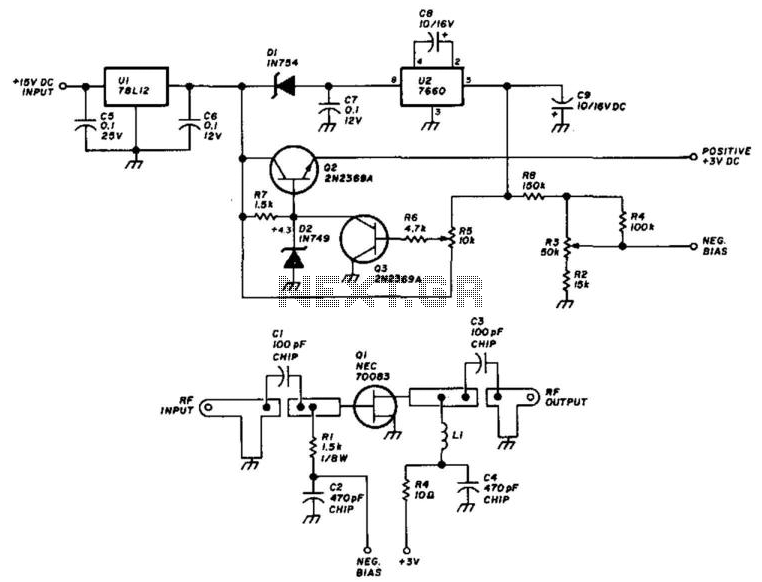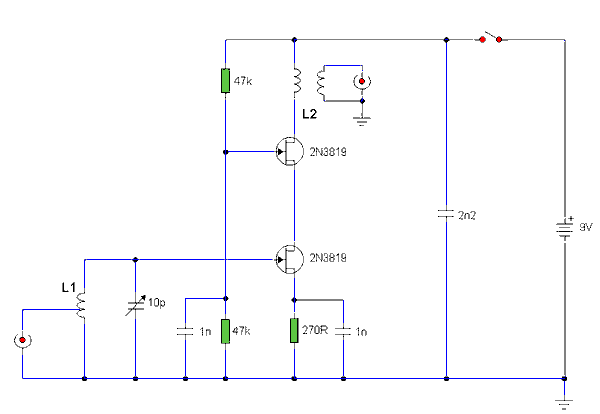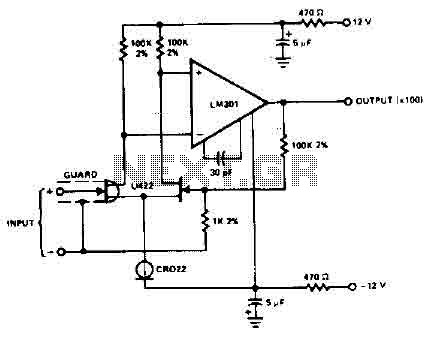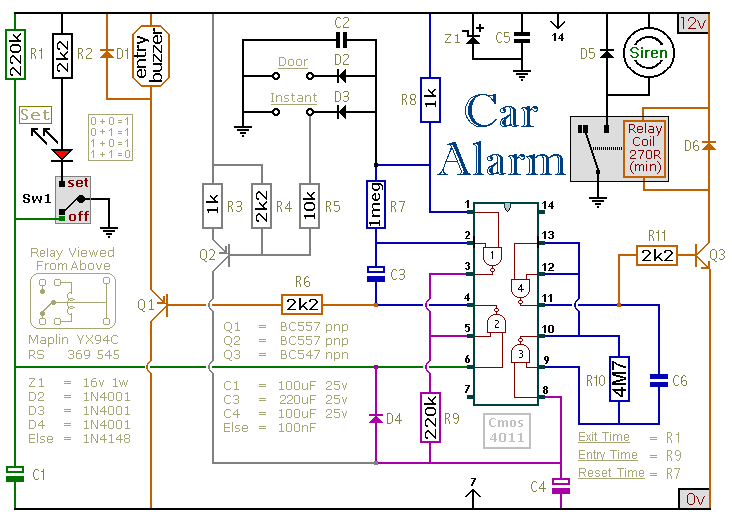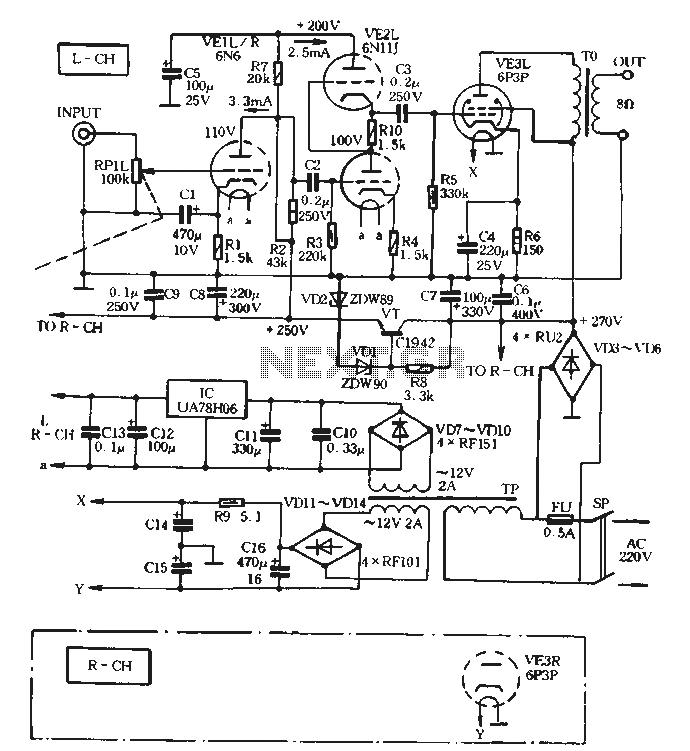
100w quad car amplifier
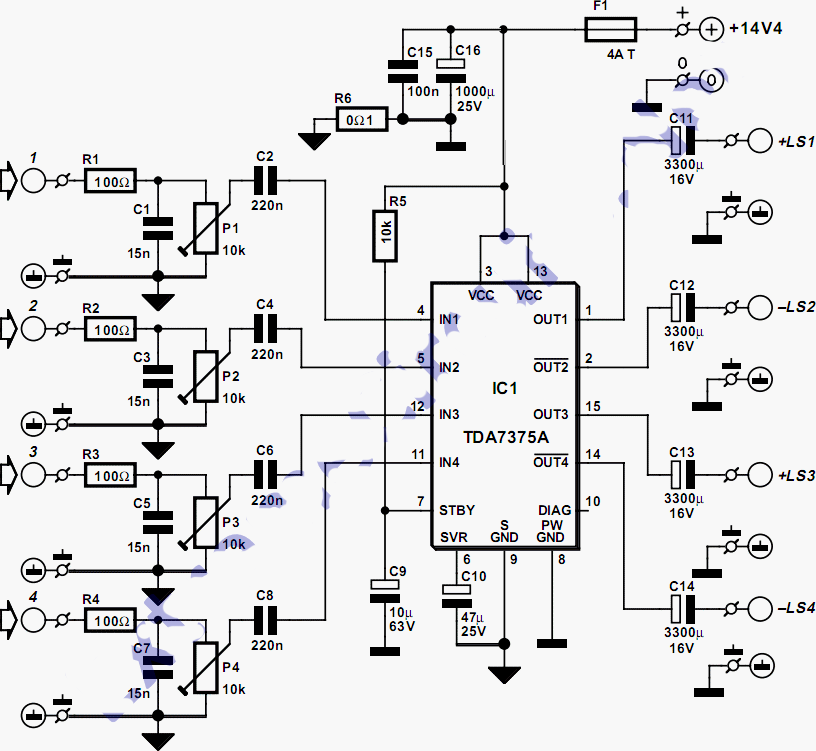
This quad amplifier is designed primarily for automotive use but can also be applied in various medium-power scenarios. The TDA7375A is suitable for situations requiring a reasonable amount of audio power with a relatively low supply voltage. It is the successor to the TDA7374B, which is integral to an active loudspeaker system described earlier. This quad IC amplifier is an excellent choice for such applications, as the individual amplifiers can be paired in a bridge configuration to deliver approximately four times the power. The new IC can handle a peak voltage of 50 V, which is 10 V higher than the TDA7374B, and is intended for single-ended operation. It incorporates numerous protective features to prevent damage to the amplifiers, making it ideal for a straightforward mini surround-sound system. For further details on the TDA7375A, refer to its data sheet. The circuit includes four trimpots for adjusting the output levels of the amplifiers individually. All inputs are equipped with RC networks (R1/C1, etc.) to block potential RF interference. The function of R6 is to isolate the grounds of the input and output stages to prevent ground loops that may occur with multiple modules. A 5-W resistor is utilized for this purpose to avoid overheating if the power supply ground connection fails. C10 decouples the internal voltage divider, which biases the internal amplifier stages to half the supply voltage. The RC network R5/C9 provides a delayed, plop-free switch-on. C15 and C16 serve as local bypass capacitors for the supply voltage. The TDA7375A offers a power supply ripple rejection of approximately 50 dB. For power supply requirements, a transformer rated at 12 V / 30 VA combined with a 10,000-µF electrolytic capacitor is the minimum, noting that the maximum allowable supply voltage is 18 V. A drawback of this quad amplifier is that two channels are inverted relative to the other two, which is indicated on the circuit board layout (e.g., +LS1 and LS4) to show the correct loudspeaker terminal connections. Radial electrolytic capacitors rated at 3300 µF/16V with a diameter of 12 mm are used for output capacitors, keeping the circuit board compact. The preferred electrolytic capacitor type is from the Rubycon ZL series, capable of handling 3.4 A of ripple current. The maximum current consumption when all four channels are driven to the clipping level with 4-ohm loads is approximately 2.1 A. The TDA7375A can also operate with 2-ohm loads, but this significantly increases the internal temperature due to the Multiwatt 15V package's thermal impedance of 1.8 °C/W. To ensure the longevity of the IC, a larger heat sink is recommended. A 4 A/T fuse has been selected for potential 2-ohm operation, while a 2 A/T fuse may suffice for 4-ohm loads. The output terminals of the amplifiers are located on the circuit board adjacent to the respective electrolytic capacitors. The ground connections for LS1 and LS2 are positioned next to their terminals, while those for LS3 and LS4 are situated on the left near the IC, optimizing current paths and minimizing distortion. Vertical car connectors (spade terminals) are employed for the power supply.
The TDA7375A quad amplifier circuit is designed to provide robust audio performance in compact applications, particularly in automotive environments. The ability to bridge amplifiers for increased power output is a significant feature, allowing for versatility in system design. The inclusion of adjustable trimpots facilitates fine-tuning of output levels, accommodating the unique requirements of different speaker configurations. The RC networks at the inputs are crucial for maintaining signal integrity by filtering out RF noise, enhancing the overall audio quality.
Ground isolation through R6 is an essential design consideration, preventing potential interference from ground loops, which can degrade audio performance. The choice of a 5-W resistor for this function is prudent, ensuring reliability under adverse conditions. The decoupling capacitor C10 plays a vital role in stabilizing the voltage supply to the amplifier stages, which is critical for consistent performance.
The power supply requirements highlight the importance of adequate transformer ratings and capacitance to ensure reliable operation within the specified voltage range. The design accommodates both 4-ohm and 2-ohm loads, with considerations for thermal management and fuse ratings that protect the circuit during operation. The compact design of the output capacitors allows for efficient use of space on the circuit board, while the selected Rubycon ZL series capacitors provide reliability and performance under high ripple current conditions.
Overall, this quad amplifier circuit exemplifies a well-thought-out design tailored for medium-power audio applications, particularly in automotive contexts, while also being adaptable for other uses.This quad amplifier is actually intended to be used in a car, but it can naturally also be used for a variety of other medium-power applications. The TDA7375A can be successfully used in all situations in which a reasonable amount of audio power is desired and only a relatively low supply voltage is available.
This IC is the successor to th e TDA7374B, which forms the heart of the active loudspeaker system described earlier this year. Such a quad IC amplifier is naturally an excellent choice for this application, especially since the individual amplifiers can be connected in pairs in the bridge con ¬guration, which allows them to provide approximately four times as much power. The new IC can handle a peak voltage of 50 V (10 V more than the TDA7374B), but what is more important is that it is also truly intended to be used for single-ended operation.
It includes all imaginable types of protection in order to avoid the premature demise of the four amplifiers, and in fact it is ideally suitable for a no-nonsense` mini surround-sound system. For more information about the TDA7375A, we refer you to its data sheet, which can be found at The circuit shown here has four trimpots for individually setting the output levels of the amplifiers.
In addition, all inputs have RC networks (R1/C1, etc. ) to block possible RF interference. The function of R6 is to separate the grounds of the input and output stages, in order to avoid possible ground loops that might arise with the use of multiple modules. A 5-W type is used for this resistor, in order to prevent it from going up in smoke if the ground connection of the power supply comes loose.
C10 decouples the internal voltage divider, which biases the internal amplifier stages to half of the supply voltage. RC network R5/C9 provides a delayed, plop-free switch-on. C15 and C16 are local bypass capacitors for the supply voltage. The power supply ripple rejection of the TDA7375A is approximately 50 dB. If you want to use only a transformer, bridge rectifier and smoothing capacitor for the power supply, the minimum requirement is a transformer rated at 12 V / 30 VA in combination with a 10, 000- µF electrolytic capacitor (remember that the maximum allowable supply voltage is 18 V).
One of the few drawbacks of this quad ampli ¬er is that two of the channels are inverted with respect to the other two. For this reason, the polarity of each loudspeaker terminal is marked on the circuit board layout (e. g. , +LS1 and LS4) to indicate which terminal of the loudspeaker should be connected where. Radial electrolytic capacitors rated at 3300 µF/16V and having a diameter of only 12 mm are used for the output capacitors, which allows the circuit board to remain relatively compact.
Our preferred type of electrolytic capacitor is a member of the Rubycon ZL series, which can handle no less than 3. 4 A of ripple current. The maximum current consumption of the circuit with all four channels driven to the clipping level (with 4- loads) is approximately 2.
1 A. The TDA7375A can also be used with 2- loads. However, in this case the internal temperature rises considerably, since the Multiwatt 15V package has a rather large thermal impedance of 1. 8 C/W. In the interest of the service life of the IC, it is thus a good idea to use a somewhat larger heat sink.
A 4 A/T fuse has been selected in consideration of possible 2- operation. If you limit the load to 4 , the fuse value can be reduced to 2 A/T. The output terminals of the ampli ¬ers can be found on the circuit board next to the associated electrolytic capacitors. The related ground connections for LS1 and LS2 are located next to the LS1 and LS2 terminals, but the ground connections for LS3 and LS4 are located on the left, next to the IC, since this gives the best current paths on the circuit board and the least distortion.
Vertical car connectors (spade terminals) are used for the power suppl 🔗 External reference
The TDA7375A quad amplifier circuit is designed to provide robust audio performance in compact applications, particularly in automotive environments. The ability to bridge amplifiers for increased power output is a significant feature, allowing for versatility in system design. The inclusion of adjustable trimpots facilitates fine-tuning of output levels, accommodating the unique requirements of different speaker configurations. The RC networks at the inputs are crucial for maintaining signal integrity by filtering out RF noise, enhancing the overall audio quality.
Ground isolation through R6 is an essential design consideration, preventing potential interference from ground loops, which can degrade audio performance. The choice of a 5-W resistor for this function is prudent, ensuring reliability under adverse conditions. The decoupling capacitor C10 plays a vital role in stabilizing the voltage supply to the amplifier stages, which is critical for consistent performance.
The power supply requirements highlight the importance of adequate transformer ratings and capacitance to ensure reliable operation within the specified voltage range. The design accommodates both 4-ohm and 2-ohm loads, with considerations for thermal management and fuse ratings that protect the circuit during operation. The compact design of the output capacitors allows for efficient use of space on the circuit board, while the selected Rubycon ZL series capacitors provide reliability and performance under high ripple current conditions.
Overall, this quad amplifier circuit exemplifies a well-thought-out design tailored for medium-power audio applications, particularly in automotive contexts, while also being adaptable for other uses.This quad amplifier is actually intended to be used in a car, but it can naturally also be used for a variety of other medium-power applications. The TDA7375A can be successfully used in all situations in which a reasonable amount of audio power is desired and only a relatively low supply voltage is available.
This IC is the successor to th e TDA7374B, which forms the heart of the active loudspeaker system described earlier this year. Such a quad IC amplifier is naturally an excellent choice for this application, especially since the individual amplifiers can be connected in pairs in the bridge con ¬guration, which allows them to provide approximately four times as much power. The new IC can handle a peak voltage of 50 V (10 V more than the TDA7374B), but what is more important is that it is also truly intended to be used for single-ended operation.
It includes all imaginable types of protection in order to avoid the premature demise of the four amplifiers, and in fact it is ideally suitable for a no-nonsense` mini surround-sound system. For more information about the TDA7375A, we refer you to its data sheet, which can be found at The circuit shown here has four trimpots for individually setting the output levels of the amplifiers.
In addition, all inputs have RC networks (R1/C1, etc. ) to block possible RF interference. The function of R6 is to separate the grounds of the input and output stages, in order to avoid possible ground loops that might arise with the use of multiple modules. A 5-W type is used for this resistor, in order to prevent it from going up in smoke if the ground connection of the power supply comes loose.
C10 decouples the internal voltage divider, which biases the internal amplifier stages to half of the supply voltage. RC network R5/C9 provides a delayed, plop-free switch-on. C15 and C16 are local bypass capacitors for the supply voltage. The power supply ripple rejection of the TDA7375A is approximately 50 dB. If you want to use only a transformer, bridge rectifier and smoothing capacitor for the power supply, the minimum requirement is a transformer rated at 12 V / 30 VA in combination with a 10, 000- µF electrolytic capacitor (remember that the maximum allowable supply voltage is 18 V).
One of the few drawbacks of this quad ampli ¬er is that two of the channels are inverted with respect to the other two. For this reason, the polarity of each loudspeaker terminal is marked on the circuit board layout (e. g. , +LS1 and LS4) to indicate which terminal of the loudspeaker should be connected where. Radial electrolytic capacitors rated at 3300 µF/16V and having a diameter of only 12 mm are used for the output capacitors, which allows the circuit board to remain relatively compact.
Our preferred type of electrolytic capacitor is a member of the Rubycon ZL series, which can handle no less than 3. 4 A of ripple current. The maximum current consumption of the circuit with all four channels driven to the clipping level (with 4- loads) is approximately 2.
1 A. The TDA7375A can also be used with 2- loads. However, in this case the internal temperature rises considerably, since the Multiwatt 15V package has a rather large thermal impedance of 1. 8 C/W. In the interest of the service life of the IC, it is thus a good idea to use a somewhat larger heat sink.
A 4 A/T fuse has been selected in consideration of possible 2- operation. If you limit the load to 4 , the fuse value can be reduced to 2 A/T. The output terminals of the ampli ¬ers can be found on the circuit board next to the associated electrolytic capacitors. The related ground connections for LS1 and LS2 are located next to the LS1 and LS2 terminals, but the ground connections for LS3 and LS4 are located on the left, next to the IC, since this gives the best current paths on the circuit board and the least distortion.
Vertical car connectors (spade terminals) are used for the power suppl 🔗 External reference
Warning: include(partials/cookie-banner.php): Failed to open stream: Permission denied in /var/www/html/nextgr/view-circuit.php on line 713
Warning: include(): Failed opening 'partials/cookie-banner.php' for inclusion (include_path='.:/usr/share/php') in /var/www/html/nextgr/view-circuit.php on line 713
